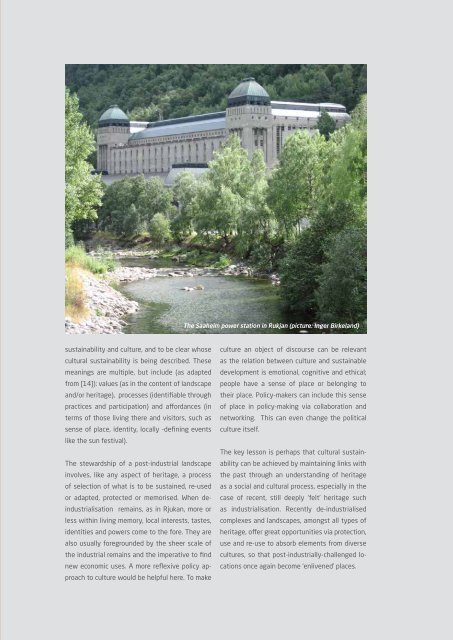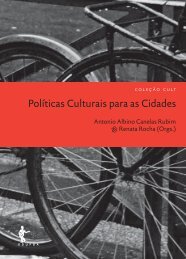Culture in for and as Sustainable Development
YIGflg
YIGflg
You also want an ePaper? Increase the reach of your titles
YUMPU automatically turns print PDFs into web optimized ePapers that Google loves.
The Saaheim power station <strong>in</strong> Rukjan (picture: Inger Birkel<strong>and</strong>)<br />
susta<strong>in</strong>ability <strong>and</strong> culture, <strong>and</strong> to be clear whose<br />
cultural susta<strong>in</strong>ability is be<strong>in</strong>g described. These<br />
mean<strong>in</strong>gs are multiple, but <strong>in</strong>clude (<strong>as</strong> adapted<br />
from [14]): values (<strong>as</strong> <strong>in</strong> the content of l<strong>and</strong>scape<br />
<strong>and</strong>/or heritage), processes (identifiable through<br />
practices <strong>and</strong> participation) <strong>and</strong> af<strong>for</strong>dances (<strong>in</strong><br />
terms of those liv<strong>in</strong>g there <strong>and</strong> visitors, such <strong>as</strong><br />
sense of place, identity, locally -def<strong>in</strong><strong>in</strong>g events<br />
like the sun festival).<br />
The stewardship of a post-<strong>in</strong>dustrial l<strong>and</strong>scape<br />
<strong>in</strong>volves, like any <strong>as</strong>pect of heritage, a process<br />
of selection of what is to be susta<strong>in</strong>ed, re-used<br />
or adapted, protected or memorised. When de<strong>in</strong>dustrialisation<br />
rema<strong>in</strong>s, <strong>as</strong> <strong>in</strong> Rjukan, more or<br />
less with<strong>in</strong> liv<strong>in</strong>g memory, local <strong>in</strong>terests, t<strong>as</strong>tes,<br />
identities <strong>and</strong> powers come to the <strong>for</strong>e. They are<br />
also usually <strong>for</strong>egrounded by the sheer scale of<br />
the <strong>in</strong>dustrial rema<strong>in</strong>s <strong>and</strong> the imperative to f<strong>in</strong>d<br />
new economic uses. A more reflexive policy approach<br />
to culture would be helpful here. To make<br />
culture an object of discourse can be relevant<br />
<strong>as</strong> the relation between culture <strong>and</strong> susta<strong>in</strong>able<br />
development is emotional, cognitive <strong>and</strong> ethical;<br />
people have a sense of place or belong<strong>in</strong>g to<br />
their place. Policy-makers can <strong>in</strong>clude this sense<br />
of place <strong>in</strong> policy-mak<strong>in</strong>g via collaboration <strong>and</strong><br />
network<strong>in</strong>g. This can even change the political<br />
culture itself.<br />
The key lesson is perhaps that cultural susta<strong>in</strong>ability<br />
can be achieved by ma<strong>in</strong>ta<strong>in</strong><strong>in</strong>g l<strong>in</strong>ks with<br />
the p<strong>as</strong>t through an underst<strong>and</strong><strong>in</strong>g of heritage<br />
<strong>as</strong> a social <strong>and</strong> cultural process, especially <strong>in</strong> the<br />
c<strong>as</strong>e of recent, still deeply ‘felt’ heritage such<br />
<strong>as</strong> <strong>in</strong>dustrialisation. Recently de-<strong>in</strong>dustrialised<br />
complexes <strong>and</strong> l<strong>and</strong>scapes, amongst all types of<br />
heritage, offer great opportunities via protection,<br />
use <strong>and</strong> re-use to absorb elements from diverse<br />
cultures, so that post-<strong>in</strong>dustrially-challenged locations<br />
once aga<strong>in</strong> become ‘enlivened’ places.<br />
35




